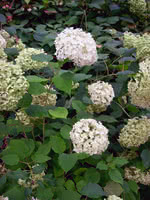Mon-Fri 9am - 5pm Mountain time
Annabelle Hydrangea vs Silky Lupine
Hydrangea arborescens Annabelle
Lupinus sericeus
CUSTOM GROW
Annabelle Hydrangea is a cold hardy shrub that is well known for its large, compact clusters of white flowers. Unlike other flowering species, Hydrangeas do best in partial shade. However, they are capable of growing in full sun if the soil is kept consistently moist.
Blooms occur on new wood, so regular pruning is encouraged in late winter. Try Annabelle Hydrangea as a border or on its own.
Silky Lupine is a native perennial wildflower known for its upright spikes of blue to violet flowers. Blooming from late spring into summer, the nectar-rich, showy blossoms attract a variety of pollinators, especially bees and butterflies. The plant’s fine, silky foliage provides soft texture and visual interest, enhancing landscapes throughout the growing season.
Silky Lupine is a nitrogen-fixing plant that enriches soils and supports surrounding vegetation. Its deep roots stabilize soil, and it spreads naturally by ejecting seeds from drying pods. If spread isn’t desired, new seedlings are easy to remove. While it is foraged by some wild animals, it contains alkaloids that are toxic to livestock. Silky Lupine is well-suited to pollinator gardens, naturalization plantings, erosion control, and ecological restoration projects.
Annabelle Hydrangea Quick Facts
Silky Lupine Quick Facts
Toxicity: toxic to sheep and other livestock

